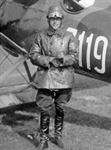Фотографии
-
The J 23 protoype, serial 3111, just after its rollout from the FVM workshops at Malmslatt in the early summer of 1923. Note the vestigial rudder attached to the fuselage sternpost, later replaced with a larger conventional fin and rudder after trials revealed directional stability problems. The J 23’s BMW IIIa six-cylinder liquid-cooled powerplant was the German company’s first aero-engine
Самолёты на фотографии: FVM J-23 / J-24 - Швеция - 1923
-
The prototype J 23, by this time fitted with a revised larger fin and rudder, takes off for a test flight. The original rudder arrangement was described by Flight as “ridiculously small by British standards... while the small control surfaces may be, and probably are, sufficient at high speeds, it is inconceivable that they can have sufficient power at or near stalling speed”.
Самолёты на фотографии: FVM J-23 / J-24 - Швеция - 1923
-
The J 24B dispensed with the parasol-wing configuration, the J 24’s damaged fuselage being repaired and used as the basis for a conventional biplane version. The latter was given the serial 5121 and, after flight testing, was handed over to test pilot Nils Soderberg as a personal hack, although it was overweight and little-used.
Самолёты на фотографии: FVM J-23 / J-24 - Швеция - 1923
-
Swedish test pilot Georg Gardin poses beside 3111 following his altitude record flight. Note the unusual slotted aileron of triangular planform on the port wing. British weekly Flight reported on the J 23 in August 1923 and explained that “as the aileron was moved up or down, the size of the slot did not change”, unlike Handley Page’s patented slotted aileron.
Самолёты на фотографии: FVM J-23 / J-24 - Швеция - 1923
-
With a further modified fin and rudder of lesser area than the prototype’s second configuration, the final production J 23, serial 3119, awaits a flight. The type’s fuselage was of elliptical cross-section, constructed of three-ply panels over a light framework of stringers and formers. The thick wings tapered both inboard and outboard.
Самолёты на фотографии: FVM J-23 / J-24 - Швеция - 1923
-
The third production J 23 (fourth in total), serial 3117, is seen here with the “low-cut” fin and rudder, suggesting that this was fitted as standard on the production models for their entry into service. The BMW IIIa engine was of the high-compression type and was capable of maintaining power up to considerable altitude.
Самолёты на фотографии: FVM J-23 / J-24 - Швеция - 1923
-
Lieutenant Wilhelm Nernst beside J 23 serial 3119. Tragically, having survived flying the notoriously tricky J 23, Nernst was killed in a mid-air collision over Simtuna in September 1924, while flying a Phonix D III. After Norberg’s death in 3111 in March 1924, the four remaining J 23s were grounded, so it is likely this photograph was taken in the second half of 1923.
Самолёты на фотографии: FVM J-23 / J-24 - Швеция - 1923
-
The August 1923 Flight report also expressed reservations about the J 23’s handling characteristics, stating that a Swedish source had revealed that “spins frequently occur”. Within seven months the J 23 had claimed a pilot’s life, when Axel Norberg was killed in 3111 after a wing detached during an irregular spin.
Самолёты на фотографии: FVM J-23 / J-24 - Швеция - 1923
Статьи
- -
- ??? - Mad dogs & englishmen
- A.Arthy - Two days in February (1)
- B.Taghvaee - The shah's Jetstars
- C.Gibson - Hawker's Star Destroyer
- F.Villeneuve - Hawk One (2)
- G.Baughen - 1940. The battle of ... Kent?
- J.-C.Carbonel - France's Air Pioneers: Louis Bleriot
- J.Forsgren - Sweden's parasol fighters
- K.Hayward - Shorts: The perennial thorn
- M.Wickstead - Italy's forgotten airlines (2)
- N.Stroud - Tuesday the 13th
- P.Davidson - Off the Beaten Track...
- P.Hobbins - Flying the "Bathfire"
- T.Buttler - Heinkel's last fighter







